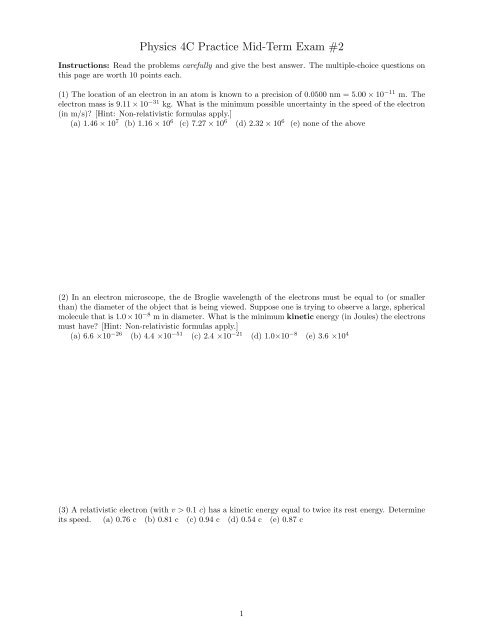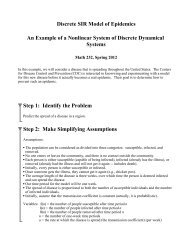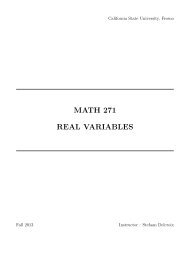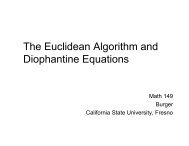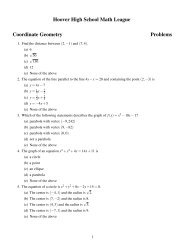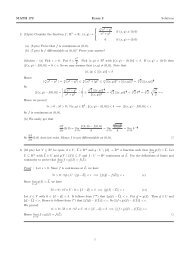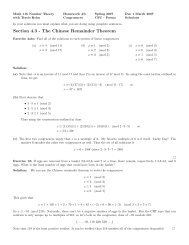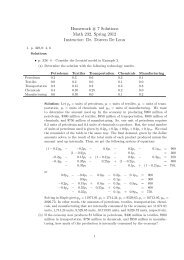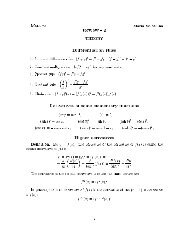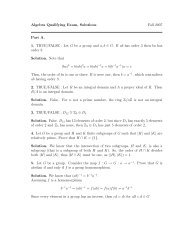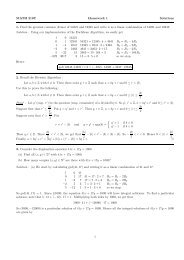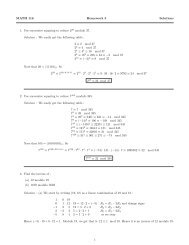Physics 4C Practice Mid-Term Exam #2
Physics 4C Practice Mid-Term Exam #2
Physics 4C Practice Mid-Term Exam #2
Create successful ePaper yourself
Turn your PDF publications into a flip-book with our unique Google optimized e-Paper software.
<strong>Physics</strong> <strong>4C</strong> <strong>Practice</strong> <strong>Mid</strong>-<strong>Term</strong> <strong>Exam</strong> <strong>#2</strong>Instructions: Read the problems carefully and give the best answer. The multiple-choice questions onthis page are worth 10 points each.(1) The location of an electron in an atom is known to a precision of 0.0500 nm = 5.00 × 10 −11 m. Theelectron mass is 9.11 × 10 −31 kg. What is the minimum possible uncertainty in the speed of the electron(in m/s)? [Hint: Non-relativistic formulas apply.](a) 1.46 × 10 7 (b) 1.16 × 10 6 (c) 7.27 × 10 6 (d) 2.32 × 10 6 (e) none of the above(2) In an electron microscope, the de Broglie wavelength of the electrons must be equal to (or smallerthan) the diameter of the object that is being viewed. Suppose one is trying to observe a large, sphericalmolecule that is 1.0×10 −8 m in diameter. What is the minimum kinetic energy (in Joules) the electronsmust have? [Hint: Non-relativistic formulas apply.](a) 6.6 ×10 −26 (b) 4.4 ×10 −51 (c) 2.4 ×10 −21 (d) 1.0×10 −8 (e) 3.6 ×10 4(3) A relativistic electron (with v > 0.1 c) has a kinetic energy equal to twice its rest energy. Determineits speed. (a) 0.76 c (b) 0.81 c (c) 0.94 c (d) 0.54 c (e) 0.87 c1
(4) The Compton wavelength of the electron is equal to the shift in wavelength due to Compton scattering(in other words, ∆λ = λ ′ − λ 0 ) when the scattering angle for the photon θ = 90 degrees. The electronmass is 9.11 × 10 −31 kg. What is the value of the Compton wavelength of the electron, in meters?(a) 3.85 ×10 −13 (b) 2.43×10 −12 (c) 5.11 ×10 −11 (d) 2.02 ×10 −9 (e) 4.42×10 −9(5) A quantum mechanical particle of mass m can only move in x, between x = 0 and x = L. If the sizeof the confining region is decreased by a factor of 1 2, the energy of the particle will:(a) decrease by 1 2(b) decrease by 1 4(c) double (d) quadruple(6) The wavefunction of a particle confined to a one-dimensional box of length L isψ(x) = A sin ( )nπxL . The walls of the box are at x = 0 and x = L. The particle can’t be outside thebox, so ψ(x) = 0 for x ≤ 0 and ψ(x) = 0 for x ≥ L. Find the constant A. [Hint: A useful integral is∫sin 2 (ax)dx = x 2 − sin(2ax)4a.]√√21(a) A =L(b) A =L(c) A = 0 (d) A = 2 L(e) none of the above2
Problems: Box your final answers. No work = No credit on this part.(A) A satellite is in a low-Earth orbit at an altitude L = 200 km = 2.0 × 10 5 m above the surface ofEarth. Its camera has a circular aperture (which is a diameter, not a radius) of D = 2.5 meters.(i) (10 points) The satellite’s camera can detect visible light, which has a wavelength of 550 nm (where1 nm = 10 −9 m). If the camera has adaptive optics, it can compensate for the blurring effects of Earth’satmosphere. However, diffraction imposes an absolute limit on the camera’s image resolution, or in otherwords, the smallest detail the camera can see. How many meters in diameter (y) is the smallest objecton Earth that this camera can resolve, or see clearly? [Hint: since the satellite is many kilometers fromEarth, sin θ ≈ y/L.](ii) (5 points) This camera is a digital camera, much like those that are commercially popular today.Digital cameras don’t use photographic film to detect light: they use electronic CCDs, or charge-coupleddevices. CCDs detect light by the photoelectric effect: photons that land on a silicon crystal knockelectrons out of the crystal, and these electrons are caught and turned into images by digital electronics.Silicon has a work function of 1.125 eV, where 1 eV = 1 electron volt = 1.602 × 10 −19 J. What is thelongest wavelength of light (in meters) that a CCD can detect? [Hint: the cutoff frequency occurs wherethe kinetic energy of the electrons drops to zero.](iii) (5 points) This satellite also has an infrared detector. It can detect thermal (also called blackbody)radiation, from objects that are not transparent to light, such as rocks, cars, or buildings. Suppose oneof these objects radiates the maximum intensity of its blackbody radiation at a wavelength λ max =10 microns = 1.0 × 10 −5 m. What is the temperature of this object, in Kelvins?3
(B) (i) (5 points) A spaceship, while stationary on Earth, is 100 m long. How long (in meters) doesthis spaceship look to observers on Earth, when it is moving away from Earth at a speed of 0.5c? [Hint:Assume Earth is stationary. This is a good approximation here, since the Earth’s motion is nowhereclose to relativistic—or in other words, nowhere close to being fast enough for relativistic effects becomenoticeable.](ii) (5 points) As the spaceship travels away from Earth at a speed of 0.5c, it launches a probe awayfrom Earth. The probe is traveling at a speed of 0.75c relative to the spaceship. What velocity doobservers on Earth measure for the probe?(iii) (5 points) If the spaceship has a mass of 1.0×10 3 kg, what is the momentum of the spaceship, asobserved from Earth, when the spaceship is moving away from Earth at 0.5c?(iv) (5 points) What is the total energy of the spaceship, as observed from Earth, when the spaceshipis moving away from Earth at 0.5c?4


